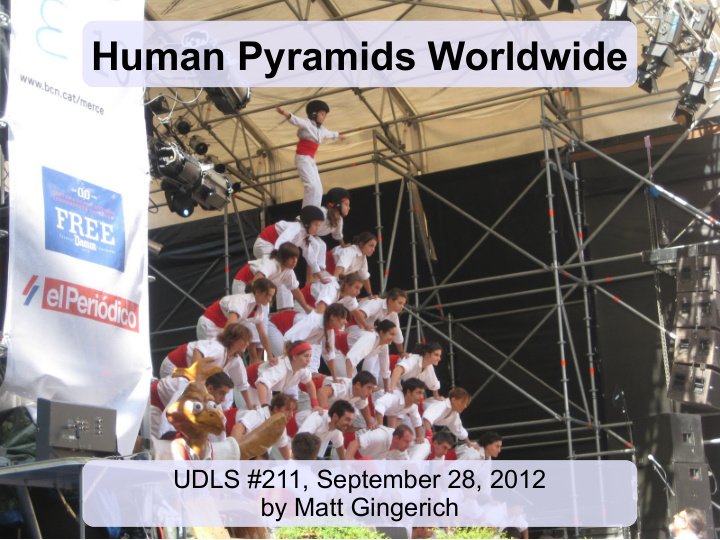



Human Pyramids Worldwide UDLS #211, September 28, 2012 by Matt Gingerich
What is a human pyramid?
Outline of the talk...
Wikipedia says... Wikipedia says...
Royal Military College of Canada Cadets, 1901
Meanwhile, in China...
Cheung Chau Bun Festival “A fun and exciting ritual for fishing communities to pray for safety from pirates.” - Wikipedia
Moving on to India...
Govinda / Dahi Handi http://www.youtube.com/watch?v=DCKSY8Fv0z4&feature=related http://www.youtube.com/watch?v=xmVFS5KS6Ek&feature=related
Catalonia
Castell ● http://vimeo.com/16392519 ● Terminology: – Pilar, Torre, Tres, Quatre, Cinc: 1, 2, 3, 4, and 5 persons per level – Pinya (“bulk”): ground-level base – Folre (“cover/lining”): second-level base – Manilles (“handles/handcuffs”): third-level base – Agulla (“needle”): a column within the pyramid – Descarregat: successful completion and dismantling – Carregat: tower completed, but falls during dismantle
Castellers de Vilafranca Tres and quatre de nou amb Torre de nou amb folre i manilles folre descarregats descarregada
Castellers de la Vila de Gràcia
Music in castell
Why? Where did castell come from? ● Balls de Valencians – Square dance with human towers – First reference in 1805 ● Competitive teams – 19 th century rivalries – Earliest groups were existing organizations: farmers, guilds, etc ● Why not?
Human Pyramids Worldwide UDLS #211, September 28, 2012 by Matt Gingerich (Pictured: a ten layer human pyramid in Barcelona, formed as part of La Mercè which also features the first castell competition of the city.)
What is a human pyramid? This talk will take a somewhat loose definition of a human pyramid... I'll include human towers such as the top-right image and weird gymnastic formations like the bottom-left image in this talk. In fact, any arrangement of people that lifts at leas one person into the air supported by more than one other person will fit my really, really generous definition of a human pyramid (so the pathetic pyramid at the bottom-right gets a pass this time).
Outline of the talk... We'll start in North America where human pyramids are seen mostly in cheerleading, gymnastics, and sports, as well as more casual “spur of the moment” pyramids. Next, we'll move over to India and China where we'll see competitive human pyramid formation as a part of some traditional festivals. Finally, we'll trek over to Catalonia, Spain which is home to the tradition of Castell and some of the most impressive human formations on the planet.
Wikipedia says... Wikipedia says... According to Wikipedia, human pyramids tend to be somewhat kinky in the United States. Oddly enough, there's no citation for that, which might explain the “original research” tag. The boy scout claim is also misleading. The source that Wikipedia cites is a boy scout manual that suggests an interesting activity of telling the scouts to form a pyramid as quickly as possible... it doesn't need to be high. The website goes on to suggest that a good strategy is to form a pileup on the ground.
LEFT: Hayden Smith of the US rugby team catches a ball during a match against Ireland. RIGHT: a cheerleading team demonstrating a pyramid- like gymnastic formation.
Royal Military College of Canada Cadets, 1901 LEFT: a series of diagrams showing acrobatic pyramids. I believe this diagram actually has German origins, but that's practically North America, right? RIGHT: RMC cadets forming pyramids in 1901.
Meanwhile, in China... Moving on to China...
Cheung Chau Bun Festival “A fun and exciting ritual for fishing communities to pray for safety from pirates.” - Wikipedia As the slide text suggests, the Bun Festival has an interesting history. Historically, as shown in the left image from 1961, the highlight of the festival was a bun snatching ceremony during which young men raced up 60-foot bamboo towers to reach steamed buns at the top. Human pyramids would often form during this event. In 1978 a tower collapsed, injuring over 100 participants. The communal climbing event was banned by the government and only a single climber was allowed to climb in the following years. In 2005, the ceremony was changed again to allow 12 trained climbers to scale a single tower (the other two towers were removed from the event).
Moving on to India...
Govinda / Dahi Handi http://www.youtube.com/watch?v=DCKSY8Fv0z4&feature=related http://www.youtube.com/watch?v=xmVFS5KS6Ek&feature=related Govinda is a sport that's organized during Krishna Janmashtami which is a celebration of the birth of Krishna. Players gather to break a pot (called a matki or handi) that is hung on a string.
Catalonia
Castell ● http://vimeo.com/16392519 ● Terminology: – Pilar, Torre, Tres, Quatre, Cinc: 1, 2, 3, 4, and 5 persons per level – Pinya (“bulk”): ground-level base – Folre (“cover/lining”): second-level base – Manilles (“handles/handcuffs”): third-level base – Agulla (“needle”): a column within the pyramid – Descarregat: successful completion and dismantling – Carregat: tower completed, but falls during dismantle
Castellers de Vilafranca Tres and quatre de nou amb Torre de nou amb folre i manilles folre descarregats descarregada
Castellers de la Vila de Gràcia
Music in castell The musical element of castle building – a high-pitched wooden flute and percussion – is more than mere entertainment. When buried deep inside the pinya, it is almost impossible to know what is going on above. The musicians – grallers (flautists) and a tabaler (percussionist) – play at very specific stages of the building process, letting everyone know when the “enxaneta” is climbing the tower, when the “aleta” is given and when the dismantling of the castle has commenced. Without these musical clues, a significant number of the castellers would have no idea of what is happening above them, and the building process would probably collapse into chaos. Text for this slide's notes is lovingly plagiarized from: http://matadornetwork.com/community/frannyink/a- very-brief-history-of-the-castellers/
Why? Where did castell come from? ● Balls de Valencians – Square dance with human towers – First reference in 1805 ● Competitive teams – 19 th century rivalries – Earliest groups were existing organizations: farmers, guilds, etc ● Why not?
Recommend
More recommend